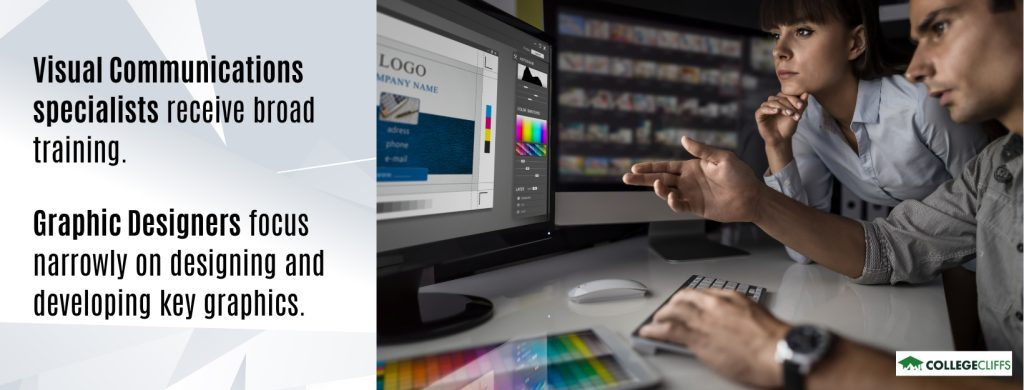Visual Communications vs Graphic Design: Career ROI
By nature, most humans are visual beings. Everything seems more understandable and clearer when people use their eyes to decipher something. It is easier to communicate information visually than it is by writing it down.
This is why modern businesses and organizations today should include a visual communication plan in all aspects of their business operations, particularly content marketing. In the process of creating content, visual components are essential.
How Visual Communications and Graphic Design Differ
Visual Communication addresses the task of communicating a message or piece of information. On the other hand, Graphic Design is a technique used by visual communicators for outputs in typography, illustration, and photography.
Let’s explore their differences:
| Visual Communications | Graphic Design | |
| Annual Average Salary | Web and digital interface designers: $83,240 | Graphic Designer: $57,990 |
| Job Growth (2022 and 2032) | 16% | 3% |
| Skill Set | * Strong analytical skills * Creativity * Information visualization * Advanced design software * Tech skills | * Design principles * Ideation * Typography * UX/UI design * Tech skills * Branding |
What is Visual Communication?

Using visual components to provoke an action, cause a change, deliver a message, or trigger an emotion is known as visual communication. To put it simply, visual communication is the act of using pictures instead of text or speech to communicate meaning, whether it be ideas, instructions, data, or other types of information.
For many, this is a more accessible and effective method of giving context and communicating knowledge than written communication.
There are many ways to communicate visually. All of these mediums can be used in visual communication:
- Charts, graphs, infographics, and other data presentation
- Texts and typography
- Videos
- Graphic Design
- Photos
- Illustrations
- Maps
- Audio
Education and Career Path in Visual Communications
A Bachelor’s in Visual Communications equips students with the technical skills to create and deliver creative, advertising, marketing, and digital media outputs. If you intend to acquire more advanced skills, pursue a master’s degree in the same or related fields.
Utilizing many of the principles of Graphic Design, Visual Communications features these specializations:
- Film and Video Communication
- Visual Communication Design
- Digital Design
- Film and Video Design
- Animation Design
- Advertising Design
- Photography
- Illustration
- Interaction Design
- Publishing
It is equally important for visual communicators in training and professionals alike to pursue and reap the benefits of continuing education (CE) courses. Join internships, expand your network, and do freelance work to build your portfolio.
A career in Visual Communications is for you if:
- You want your creativity to serve the good purpose of conveying important messages.
- You want to evoke an impact or change using visual elements.
- You are open to working with diverse people.
A career in Visual Communications is not a great fit if:
- You prefer traditional communication instead.
- You are not tech-savvy.
- You are not interested in journalism, advertising, design, and the arts where successful visual communication is essential.
What is Graphic Design?

Experts in the field of Graphic Design create images that communicate concepts. Visual hierarchy and page layout techniques are tools used by Graphic Designers to customize typography and graphics to meet the specific needs of clients or businesses.
They take into account the sensible placement of components in interactive designs to create high-quality digital and physical goods.
Education and Career Path in Graphic Design
Graphic Designers can flourish more in their careers when they get an education. With a Bachelor’s in Graphic Design, you learn the fundamentals principles, tools, strategies, and skills for excellent Graphic Designing outputs.
Graphic Design courses feature a wide array of tools, color theory, design, user experience, layout, typography, and software. Graduate programs in Graphic Design feature advanced courses, making them better equipped for top-level careers in the arts, digital media, and design-related careers.
At any academic level, students must value every opportunity to network with industry professionals.
Graphic Design Specializations:
- Environmental Design
- Typography
- Packaging Design
- Advertising Design
- Publication Graphic Design
Graphic Design relies heavily on software such as Adobe Creative Cloud, PhotoShop, Illustrator, and InDesign. Expectedly, graphic designers must be adept with these tools and continuously work to enhance their technical skills.
Here’s a tip to elevate your employment prospects in Graphic Design: create a winning portfolio that showcases your skill and makes yourself marketable! Create a personal website and be active on social media.
A career in Graphic Design is for you if:
- You express your creativity through physical and virtual designs.
- You are confident with your design skills.
- You are naturally creative.
A career in Graphic Design is not a great fit if:
- You are not a fan of color theory.
- You don’t like making sample projects.
- You don’t like mastering tools and skills.

Additional Information:

